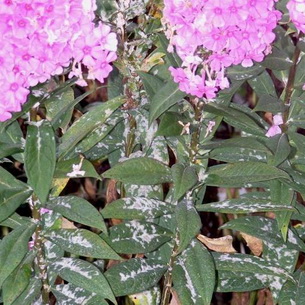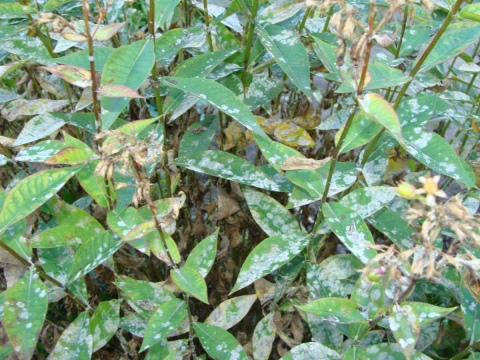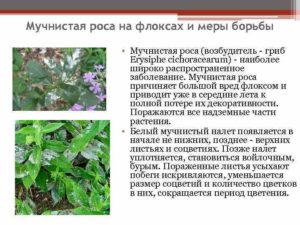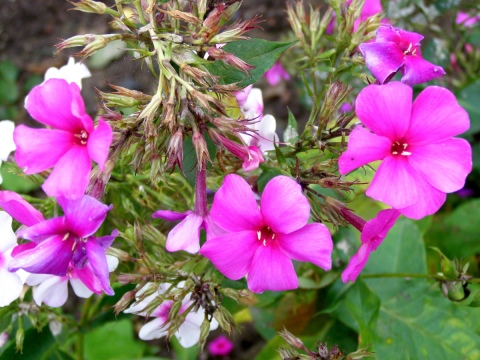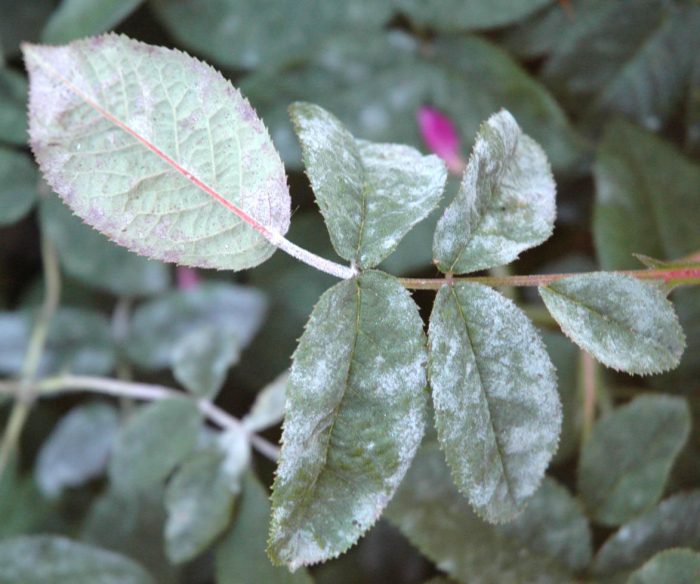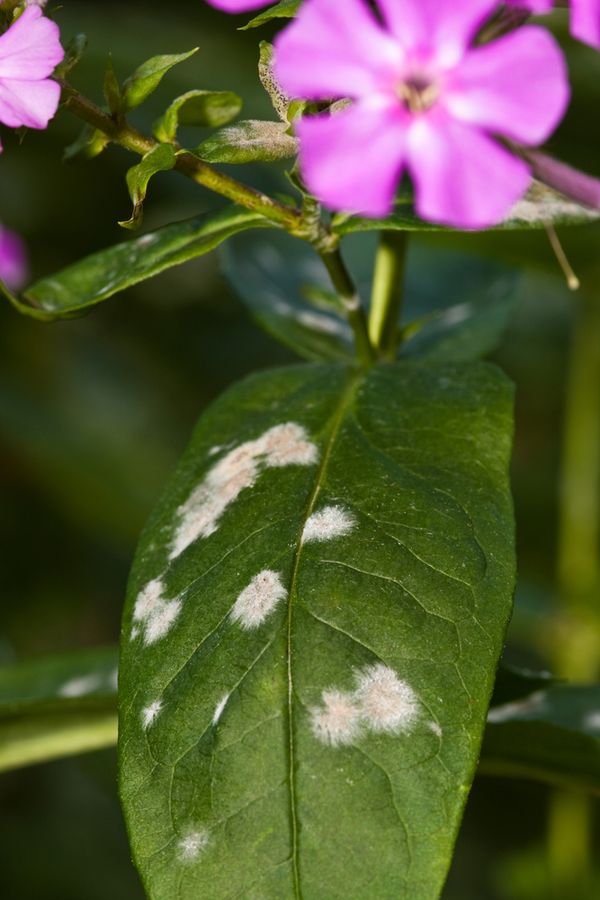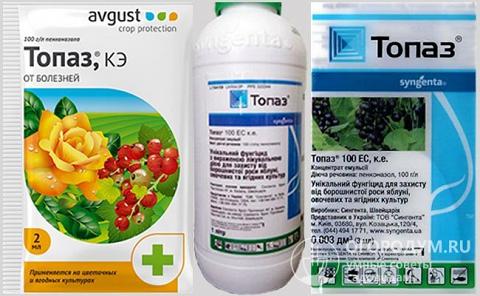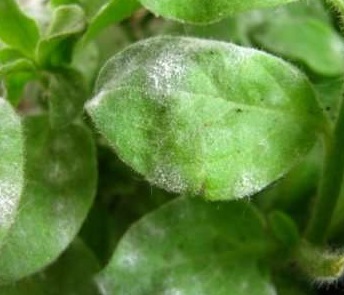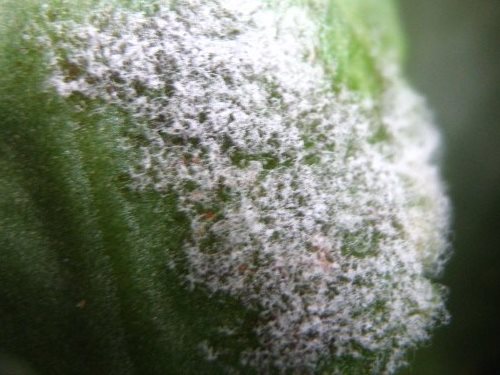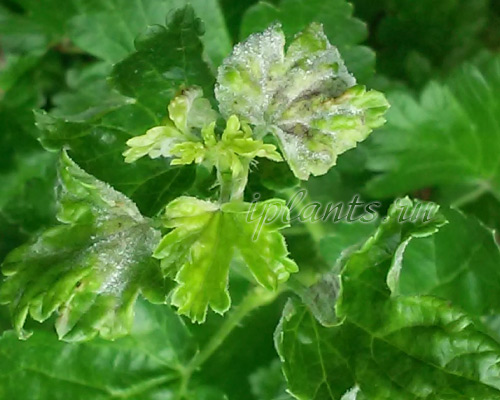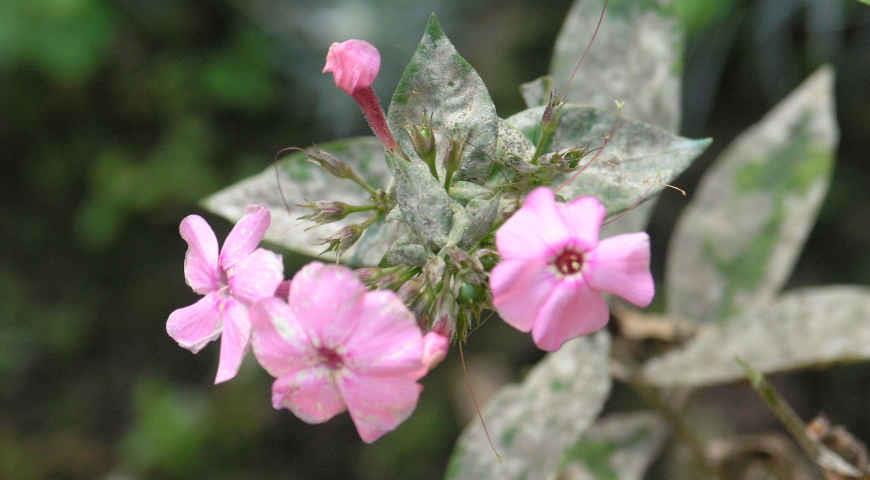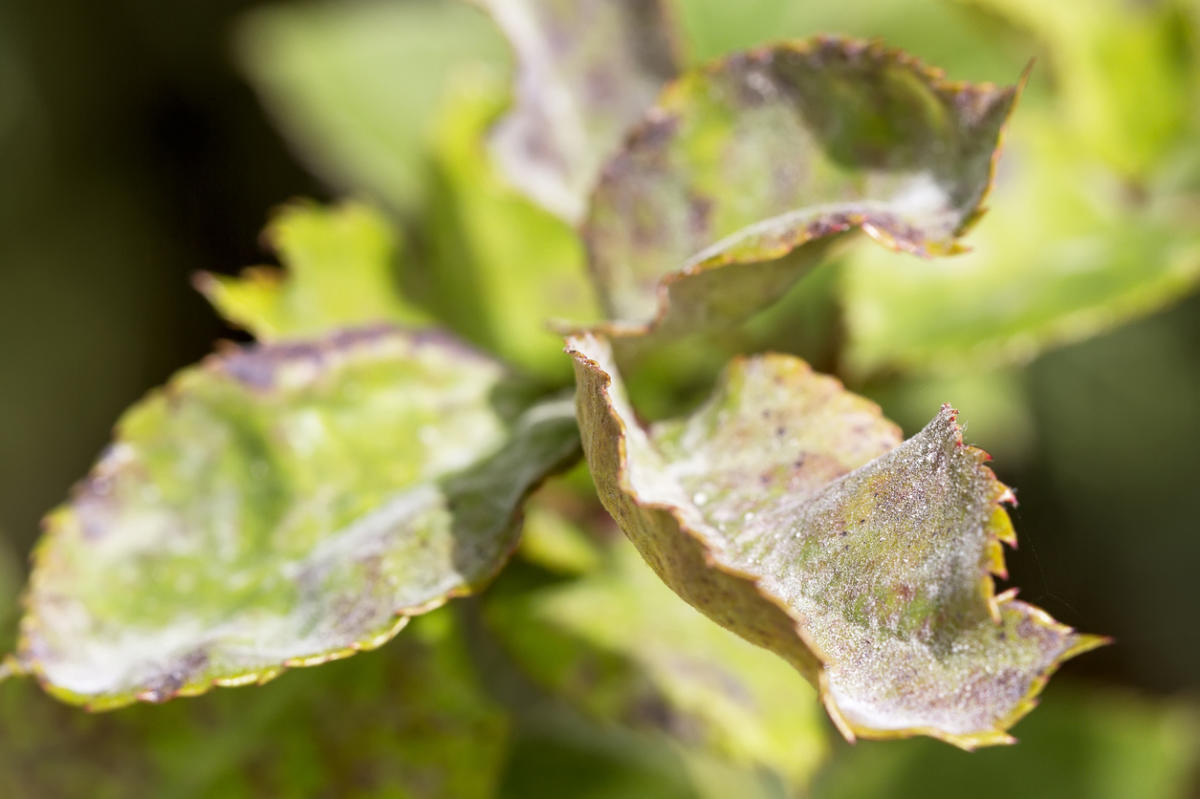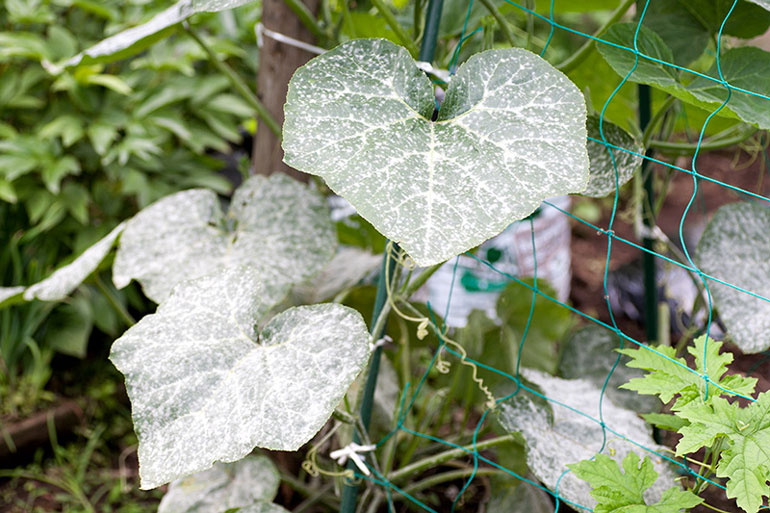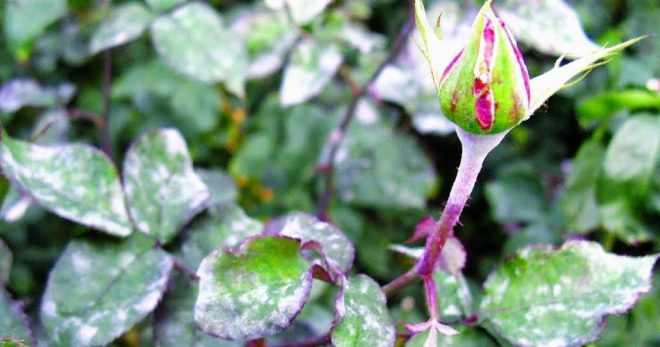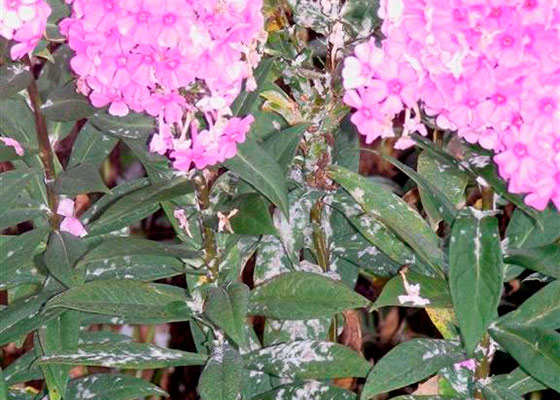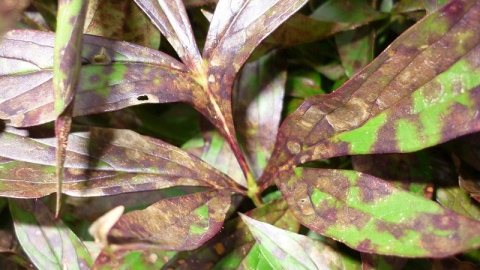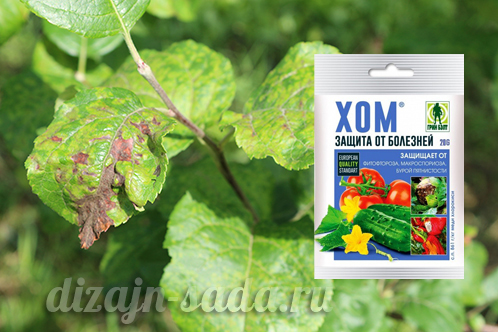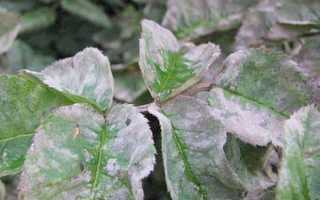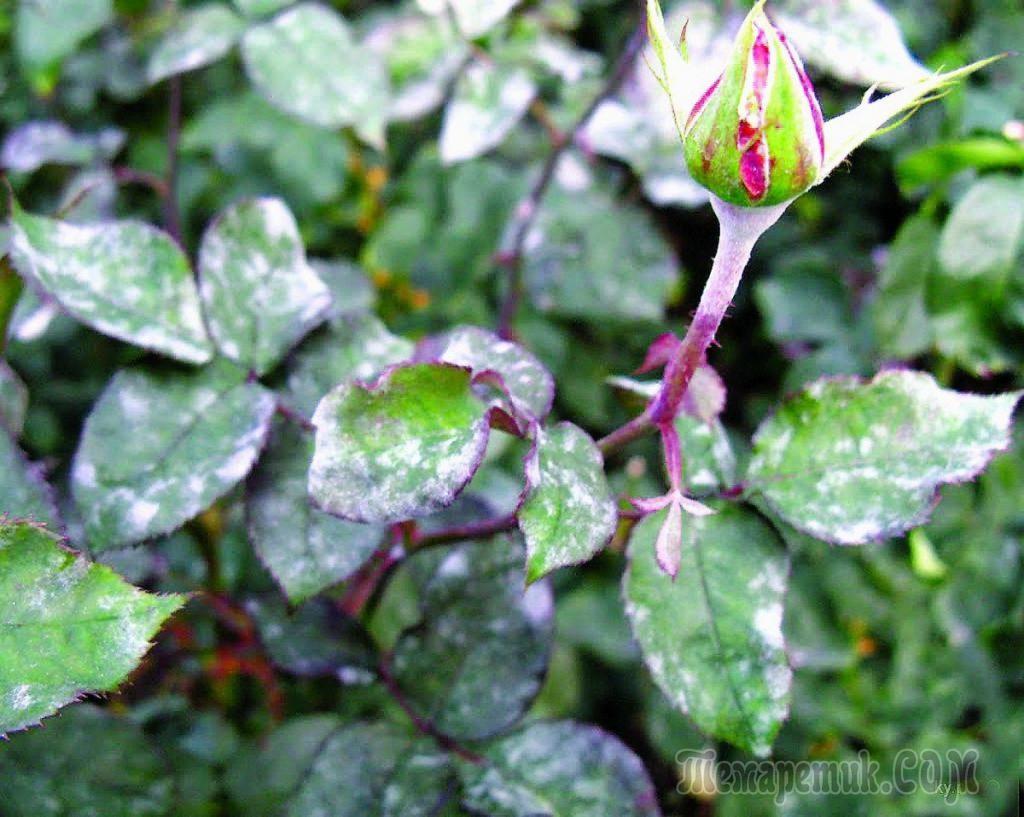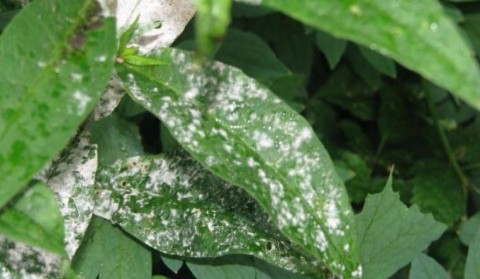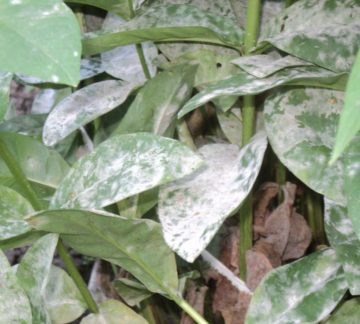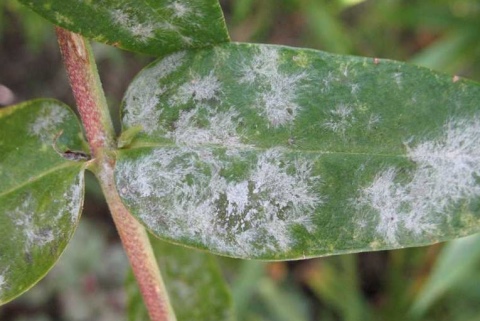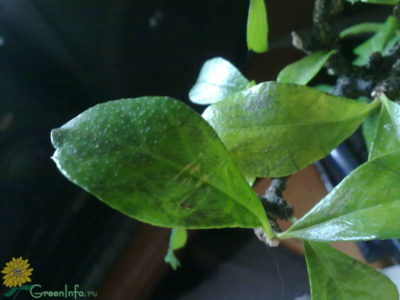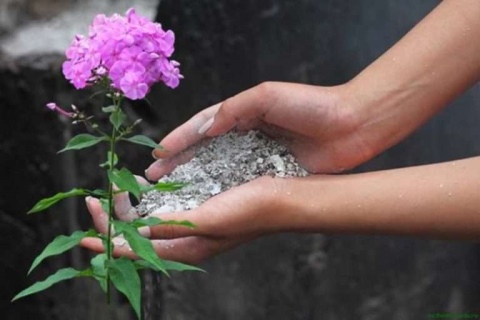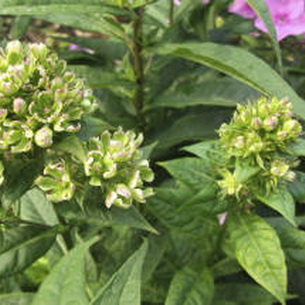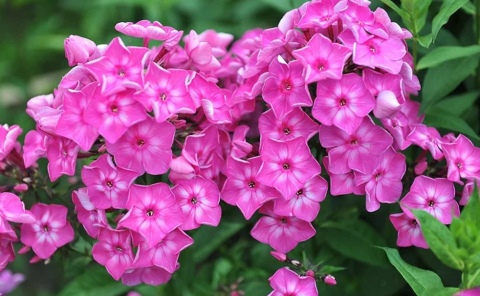Plants vulnerable to powdery mildew
- Pumpkin family - cucumbers, zucchini, pumpkins, melons, watermelons, etc.
- Solanaceous crops - tomatoes, peppers, eggplants, potatoes, etc.
- Strawberries (not to be confused with gray rot, the defeat of which is visible only on berries).
- Berry bushes - rose hips, gooseberries, currants; less often raspberries, honeysuckle, viburnum, etc.
- Fruit trees (apple, rarely pear, as well as peaches, etc.).
- Grapes (on it, especially in the southern regions, a special type of disease develops, which is called powdery mildew).
- Various perennial flowers, ornamental shrubs, trees: roses, clematis, honeysuckle, peonies (due to this disease, they may not bloom), hops, maples, phlox, delphiniums, rudbeckia, autumn asters, monards, primroses, etc.
- Annual flowers: petunias, balsams, dahlias, zinnias, salvias, drummond phlox, calendula, sweet peas, etc.
- Lawn grasses.

Powdery mildew infection methods
Spores get on plants from the soil and organic remains inseminated by them, they remain on the branches of bushes (where they successfully winter), frames of greenhouses and greenhouses, garden tools, clothes. They can be carried with water, wind, on hands, on the soles of shoes (including from other people's infected gardens), and also move from indoor flowers, purchased bouquets. The disease develops successfully in a humid and warm environment. In addition to rains, outbreaks of the disease are provoked by hot daytime weather, which is accompanied by abundant night dew. Soil drought is also harmful, it weakens the intracellular environment of plants, and it becomes difficult for them to fight infection.
Signs and dangers of powdery mildew
In late spring, summer and even autumn, on previously healthy rose plants (both outdoor and indoor), a white powdery bloom may seem to appear from nowhere. All ground parts of the plant are covered with it - leaves and shoots (primarily young), buds and even thorns.
This "powder" is easily erased even with a finger, so that inexperienced growers may not attach importance to an incomprehensible phenomenon. And in vain - after a few days, the plaque will appear in the same place again, and it will greatly increase in size and capture all new areas, because this is a sign of damage by powdery mildew, which can quickly destroy both the infected plant itself and neighboring crops.
It is not only roses that suffer from this disease. The fungus also actively affects many other garden and garden plants - pear and apple, zucchini and beets, currants and gooseberries, grapes and strawberries, cabbage and cucumbers.
The culprits of this disease are microscopic powdery mildew parasitic fungi, whose spores are easily carried by wind, precipitation, and even transmitted from plant to plant through clothing and poorly disinfected garden tools. The pathogen hibernates in cracks in the bark, in leaf litter and even under the scales of dormant buds, and in the spring it begins to grow and multiply.
The leaves and buds of the affected bushes wither, turn yellow and fall off - a white bloom (mycelium) greatly impedes photosynthesis. New leaves sometimes appear in their place, but most often they will be shriveled and underdeveloped. The plant itself is greatly weakened. If you do not take measures to cure powdery mildew, the rose will die.
The most vulnerable to the fungus that causes powdery mildew are hybrid tea and remontant roses.
Fungal white bloom on roses most often develops in conditions of poor lighting and thickening of rose bushes, poor soil aeration, sharp fluctuations in temperature and humidity of air and soil, excess nitrogen fertilizers and a lack of calcium in the substrate.All this leads to impaired immunity, weakening of plants and, as a result, to the appearance of powdery mildew.
The best way to combat powdery mildew
Every experienced gardener will say that the best way to fight a fungal disease is to prevent it. From the very beginning of summer, the plant needs to be disinfected with copper-based preparations (Topaz or any other fungicide). A good result will be given by the treatment of phloxes with a furacilin solution (20 tablets / 10 l of water).
Important! In the treatment of already diseased plants, there is a strict rule: in order to save them, you need to spray the neighboring plants with special preparations. 5 main rules for the prevention of powdery mildew
5 main rules for the prevention of powdery mildew.
- Repot the phlox to a new location every 4 years.
- Thin the stems to provide optimal ventilation for them.
- Dig up the ground.
- If you notice signs of leaf damage, pick them off without delay. Then burn it.
- Try to choose for growing those varieties that are resistant to diseases.
If the preventive measures did not help or you, for example, forgot to process the plants at the beginning of summer, do not despair, diseased phlox can be saved in most cases.
Preventive protective measures
To protect against the development of the disease, it is recommended to carry out the following preventive work:
- fungicide treatment;
- removal of severely affected leaves and branches;
- thinning the crown;
- autumn digging of soil and its disinfection;
- sufficient application of potash and phosphorus fertilizers;
- reducing or eliminating the use of nitrogen fertilizers;
- planting varieties of apple trees resistant to powdery mildew.
Important! Without waiting for signs of powdery mildew to appear in the garden, it is worth resorting to preventive treatment of the apple tree with copper-containing preparations. You can use both traditional preparations - copper sulfate, Bordeaux mixture, and modern means:
You can use both traditional preparations - copper sulfate, Bordeaux mixture, and modern means:
- Hom;
- Horus;
- Topaz;
- Speed;
- Maksim;
- Acrobat.
Such treatment will protect against various infections. Moreover, many drugs are not dangerous to humans:
- Speed;
- Maksim.
Despite the widespread use of traditional protective equipment, copper-containing substances are toxic. They should be used when the plants are completely dormant: in early spring or late autumn. The first spraying is carried out before bud break, the last - after harvesting and the foliage begins to fall.
The German drug Bayleton provides 30-day protection of the apple tree from infection. Moreover, it protects not only the places that the sprayer took out, but also the entire plant, as it penetrates into all the tissues of the apple tree.
Every year, gardeners spray apple trees before and after flowering with harmless homemade compounds:
- soap and soda solution (50 g of soda, 40 g of liquid soap per 10 liters);
- a solution of serum with water in a ratio of 1:10;
- decoction of horsetail (100 g of grass per 10 liters);
- a solution of potassium permanganate (3 g per 10 l).
The environment that these products create is detrimental to the fungus, prevents it from ripening and spraying.
Spraying is carried out not only on the crown and trunk of the apple tree, but also on the soil under the tree. Disinfection of the earth in the fall with a 5% solution of copper sulfate is a mandatory procedure.
Prevention of powdery mildew
If powdery mildew has already been noticed on your garden plot, in early spring, as soon as leaves begin to unfold on fruit bushes, spray the bushes with Topaz or Vectra (their action is directed specifically on powdery mildew). After 2 weeks, repeat the spraying of the leaves and the formed ovaries. The third spraying will be after harvest.
Follow the general rules of prevention:
- Destroy infected plant debris by burning all leaves and shoots showing signs of disease.
- Weed the weeds, many are prone to infection.
- Observe the crop rotation, do not re-plant crops prone to powdery mildew in the same place.
- Purchase seedlings and seeds of plants that are genetically resistant to disease.
- Provide adequate air circulation, avoid crowded plantings, and thin out seedlings and seedlings.
- Disinfect the tools you use to cut or tie (ribbons and ropes, pruning shears, etc.).
- If you use the principle of sprinkling, then water the vegetables and berries in the morning so that the plants can dry out during the day. Better yet, opt for a drip system to help keep the leaves dry.
- Do not overdo it with nitrogen fertilizers, but apply phosphate fertilizers regularly.
Powdery mildew serum
Milk whey works best as a prophylaxis, not a treatment, it is worth using if you notice infected plants, trees or weeds somewhere nearby. You need to protect susceptible crops: gooseberries, currants, roses, etc.
There is no difference in what to spray - milk or whey (skim) - only in price, both products contain milk proteins, and we need them.
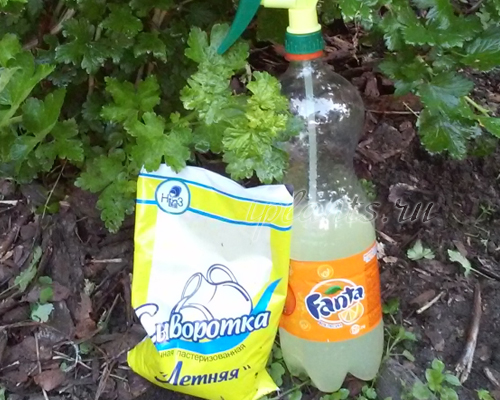
Exactly how whey works against fungus, no one knows for sure, it is assumed that milk proteins have an antiseptic effect when exposed to sunlight. Therefore, processing with milk and whey is carried out not in the evening, but at 10-11 am in sunny weather. The milk solution should be moistened on both sides of the leaves until it flows to the ground.
How to dilute whey with water against powdery mildew: for 1 part of milk (whey) we take 2 - 3 parts of water. Spray the solution onto plant leaves every 10-14 days. If you want - you can more often - once a week.
Sometimes you can find a recipe for powdery mildew, where reverse, whey, sour milk or kefir (yogurt) are used in a 1:10 dilution with cold water. Trust me - it doesn't work, concentration is too weak! We dilute 1: 2 or 1: 3, and repeat every week.
Ash from powdery mildew
Good prevention of spherotek, i.e. spraying before symptoms of the disease appear - ash treatment. To do this, take 1 kg of clean wood ash, sifted from debris, and pour 10 liters of water. Leave the solution to infuse for 3 - 5 days, stir occasionally. Add a couple of spoons of grated soap. Strain the solution through a thin cotton cloth into the sprayer to avoid clogging the spray bottle.
Features of the manifestation of powdery mildew on phlox
The source of the disease is the mushroom Erysiphe cichoracearum. The defeat is observed in the spring during the vigorous flowering of the plant at the moment when the overwintered mushroom spores break out from the spore-forming organ and are transferred to the flowers with the help of the wind.
The first symptoms will be clearly visible only in July. Initially, small white spots appear on the lower plates, which immediately grow, turning into a powdery bloom. Subsequently, it becomes denser and takes on a brown tint. Then the leaf dries up. Gradually spreads to the upper branches, inflorescences.
The newly formed leaves, which have not yet had time to acquire a protective layer, are most and more easily infected.
Favorable conditions for the emergence and development of the disease are temperatures + 18 ... + 20 ° C and high humidity. Also, this is facilitated by the excessive presence of nitrogen in the ground, improper watering, fluctuations in temperature regimes.
How to deal with powdery mildew
The fight against the disease must be approached in a comprehensive manner. First of all, you need to revise your methods of caring for flowers and correct all obvious mistakes. The first steps in plant treatment:
- it is necessary to water phloxes in summer only when the ground under them is completely dry;
- stop spraying the leaves of the plant until it is completely recovered;
- if possible, transplant phloxes to an open area, where they will be under the sun for a longer time;
- be sure to thin out dense plantings, remove leaves that are near the ground itself;
- do not fertilize diseased plants, and after treatment use only those fertilizers that contain potassium and phosphorus.

The defeat of phlox with powdery mildew
Important! If you do not reconsider the method of care and eliminate the errors, then the treatment of flowers will be ineffective. After all the errors have been corrected, you can start treatment.
Leaves that have become covered with white spots need to be urgently removed and burned. Then treat the plants with fungicides. These drugs do not allow the fungus to multiply and stop all processes that began in the plant due to the effects of bacteria.
After all the errors have been corrected, you can start treatment. Leaves that have become covered with white spots need to be urgently removed and burned. Then treat the plants with fungicides. These drugs do not allow the fungus to multiply and stop all processes that began in the plant due to the effects of bacteria.
Phlox treatment with pesticides
How to properly spray the plant is indicated on the package of the substance that was chosen for the treatment. Flowers are processed once a week. The most effective fungicides are recognized by gardeners:
- topaz;
- pure color;
- fast;
- balayton;
- topsin;
- foundationol.
They will be equally effective for processing flowers and berries.
Important! But it should be remembered that before using them for their intended purpose, you need to carefully study the instructions and strictly follow the recommendations.
Folk methods
If there are no pesticides at hand, then how to treat white plaque on phlox? Most gardeners still choose the old grandmother's methods to get rid of plant ailments. All of these products are cheap, while their ingredients are found in every home, so it will not be difficult to prepare medicinal solutions.
- Gardeners most often use ash solution. To do this, 150 g of wood ash are soaked in 1 liter of water and let it brew for two days. After that, 4 g of gray laundry soap is added to the solution, it is completely dissolved and phlox is treated. The procedure must be repeated after 14 days.
- For the second recipe, you need to take 400 g of soda ash, fill it with 1 liter of water and mix thoroughly. After that, add 400 g of gray laundry soap, previously crushed into shavings, into the solution. Allow the soap to dissolve and process the phlox. Repeat the procedure after two weeks.
- You can also fight the disease with the help of cow dung. For this, it is also diluted with water and used as a fungicide.
- They relieve phlox from diseases and weed infusions. Any weed that grows in the garden is used. It is poured with water and allowed to brew. After five days, the infusion is filtered and used as directed.

Serum diluted with water is excellent for phlox disease
- It helps well to destroy horsetail fungus. It can be taken both dry and green. The plant is insisted in 10 liters of water throughout the day. After that, the solution is boiled, cooled and filtered. The finished substance is sprayed on the leaves of the plant.
- Gardeners also have a positive attitude to the preparation prepared on the basis of whey. For this, 100 g of a dairy product is diluted in 1 liter of water and left for 24 hours to infuse. Only after that, the ready-made solution can be used for its intended purpose.
- Garlic-based preparation is no less popular. To prepare it, you need to take 50 g of garlic, grind it into porridge, pour 2 liters of water and leave for a day. After that, the solution is filtered and the affected areas of flowers are treated with it.
Important! All the ingredients in these recipes are not harmful to flowers, but with their help it is easy to get rid of fungi.
Compliance with agricultural techniques
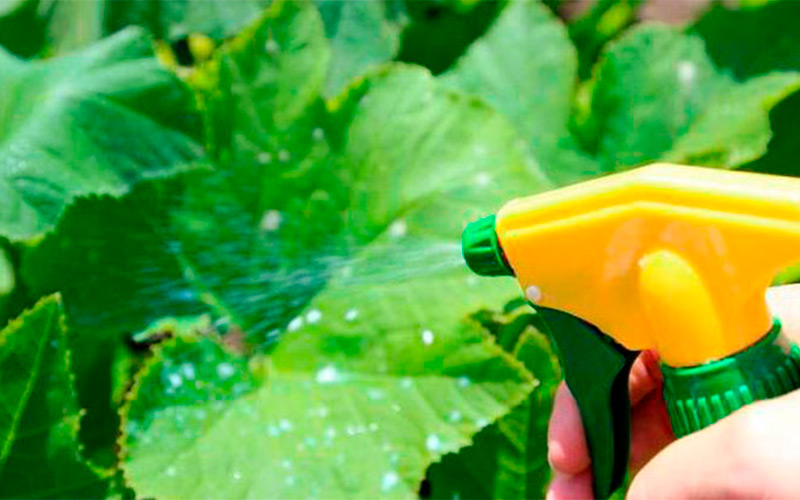
The infection occurs most often where the rules for caring for vegetables planted in the beds are not followed.
What they pay attention to:
- seedlings are planted according to the scheme, maintaining distances and avoiding thickening;
- regular and standardized watering, taking into account weather conditions, the state of plantings (excluding an excess of moisture in the soil or drought);
- application of fertilizers with an accurate calculation of the components (nitrogen - strictly in proportions);
- removal of old yellowed leaves, shoots;
- disinfection of garden and garden tools;
- timely weeding.
Correct agrotechnical techniques are a guarantee that powdery mildew will "forget" about your site.
What is powdery mildew
A fungal disease called apple powdery mildew can be distinguished from other infections by its characteristic features:
- leaves, petioles and shoots are covered with a powdery white coating, which darkens over time;
- inflorescences are also tightened with a dense whitish bloom, deformed and fall off, without forming an ovary;
- brown spots grow on the fruits, which often crack, the flesh of the apple becomes cork.
Important! The white coating changes color over time and turns brown-gray, and then darkens. On the leaves of an apple tree, the disease is expressed in the most specific form - their color changes from green to gray-white.
The defeat of the leaves in this disease is the strongest. After a while, the leaves acquire a lanceolate shape instead of an oval one, coarse, curl and, finally, completely dry out.
On the leaves of an apple tree, the disease is expressed in the most specific form - their color changes from green to gray-white. The defeat of the leaves in this disease is the strongest. After a while, the leaves acquire a lanceolate shape instead of an oval one, coarse, curl and, finally, completely dry out.
At the initial stage of infection, new shoots are covered with a white bloom, which then darkens and turns brown-gray. For young shoots of branches, the development of the disease ends with the formation of black spots of the fruit bodies of the fungus and drying out.
The inflorescences also change color. The white color changes to a yellow-green hue, with a pronounced deformation of the stamens and pistils. The inflorescences are bent, the flowering is noticeably weakened. Flowers prematurely fade and fly around.
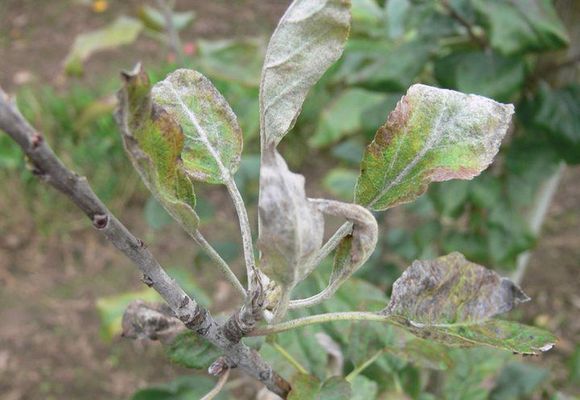
The infection greatly reduces the yield, as it prevents the formation of ovaries. Apples with affected stalks fall off before they reach full ripeness. The disease affects the fruits of the apple tree, ripe fruits become covered with a dark coating, lose their taste and aroma.
High yields, which are usually characteristic of an adult apple tree, are a thing of the past. The fungus simply does not allow the development of either leaves or fruits.
The causative agent of powdery rose is a parasitic fungus from the class of phycomycetes (Erysiphales). Unlike many other fungal diseases, this infection is activated not in summer, but in early spring, when the first leaves appear on the apple tree. The incubation period for the development of the fungus lasts about a week. Sporulation of a mature pathogen - up to 90 days.
The conditions for the development of powdery mildew, like all fungal diseases, are humid and warm weather.
Powdery mildew on an apple tree is a source of infection for the rest of the garden's plants. Cucumbers, zucchini, pumpkins, black currants, gooseberries are especially susceptible to this disease. Therefore, having seen the characteristic powdery coating on the leaves, you should immediately begin to destroy the pathogen.
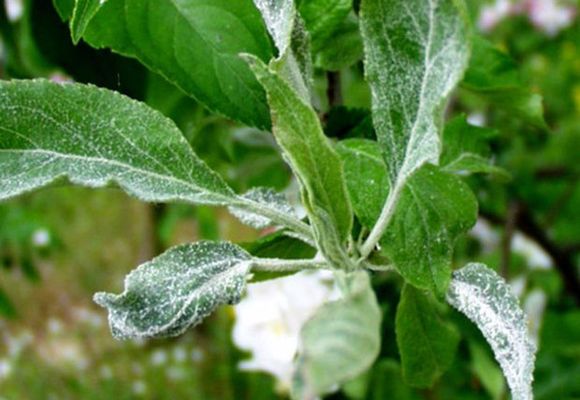
The causes and features of the manifestation of the disease
Many, of course, are interested in why a white bloom appeared on the leaves of phlox, what to do in this case. Powdery mildew is nothing more than a fungus. It appears as a result of infection with fungal bacteria that live in the soil. The conditions are sufficient for the disease, and it will affect large areas. If you grow a flower correctly, observing all the rules, then the disease will not manifest itself.
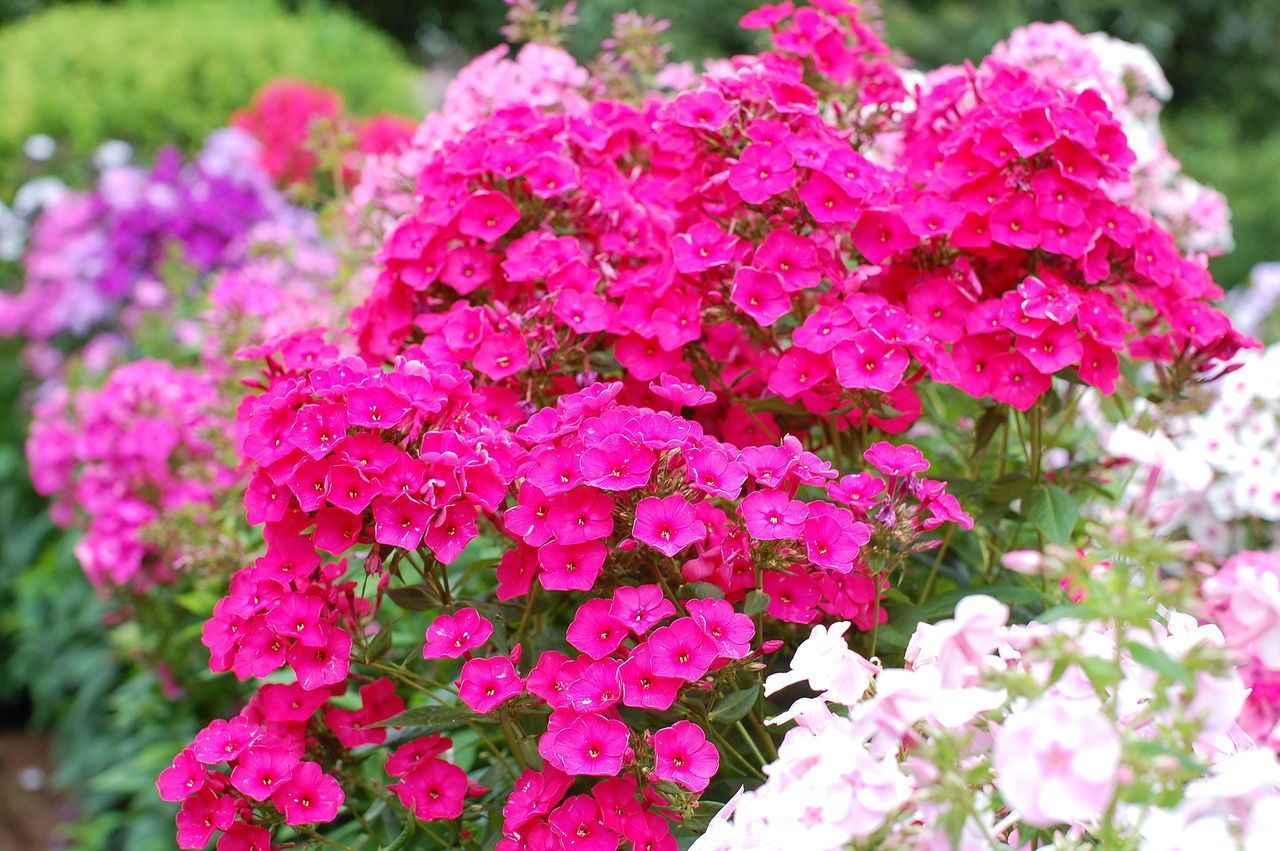
Multicolored phlox in the garden
Fungal bacteria will develop if:
- during the summer period, the rainy weather charged, it is constantly cloudy and humid, the sun rarely appears. Such weather conditions are negative for plants that are planted on the street or balcony;
- a large amount of fertilizers containing nitrogen have been applied to the soil;
- flowers are planted very densely and shade each other;
- improper watering of the plant also affects the appearance of the fungus. You can not water phlox very often, the earth must be able to dry out. Also, in dry weather, it is not recommended to immediately pour a huge amount of water under the flowers.
Important! Fungal spores are easily airborne. This can happen even at the moment when the gardener touches the diseased stem with his hand, and then approaches the healthy flower.
The causes of the onset of the disease
 The reasons why the leaves of the apple tree turn white are considered to be:
The reasons why the leaves of the apple tree turn white are considered to be:
- Fog,
- Rosu,
- Increased air temperature.
Added to these factors is a decrease in the resistance of trees and shrubs to disease due to dry weather and lack of moisture.
The combination of these conditions leads to plant infection. The resistance of apple trees to disease decreases due to sharp fluctuations in air humidity.
The source of infection, due to which the leaves of the apple tree turn white, hibernates in infected buds or as a fruiting body on branches and leaves.
Then the condia are carried by the wind through the garden, hitting new healthy trees. In this way, the apple tree becomes infected a second time.
Powdery mildew reveals itself after the tree has bloomed and is repeated several times at the beginning of the growing season. The incubation period of the disease lasts up to ten days and depends on weather conditions and the resistance of the apple tree to infection.
Spraying and watering

To combat powdery mildew, dozens of different fungicidal preparations and biological agents have been created. But such fungicides as Topaz, Acrobat, Tiovit-Jet are recommended for advanced forms, while it is better to use compositions according to folk recipes to prevent and treat infection at an early stage.
Less toxic solutions and infusions from natural raw materials are safe for humans, do not accumulate in vegetables, fruits, berries, and are detrimental to dangerous fungi.
Popular remedies:
- Iodine against powdery mildew. Measure 10 ml with a syringe, dilute in a bucket of water (10 liters). Damaged plants are moistened with a sprayer. In order for the solution not to drain, add shavings of household or 2 tablespoons of green potassium soap. For roses and phloxes, the iodine concentration is increased to 20 ml.
- Composition of copper sulfate and laundry soap. For a ten-liter bucket of water, 20 grams of vitriol and 300 grams of soap are enough. Both preparations are separately dissolved in a small amount of hot water, then the second composition is poured into the soap solution. Everything is thoroughly mixed, filtered.
- Any milk solution (from whey, kefir, milk) is considered an effective remedy. The products contain milk proteins that “work” against pathogens. When exposed to sunlight, proteins suppress mycelium spores, therefore it is recommended to process plantings not in the evening, but in the morning (until 11 o'clock). For 3 parts of water, take 1 part of the dairy product, mix thoroughly. Moisten the leaves on both sides, process the stems, shoots of plants. Spraying is repeated every 15-17 days, both to prevent infection and at the first signs of fungus.
- Ash infusion. Wood ash (1 kg) is sieved, poured with hot water (10 liters). Leave for 4-5 days, add shavings of laundry soap. Everything is mixed, filtered again.
- Mustard powder will help fight the spheroteka. In hot water (10 liters), gently stir a couple of tablespoons of the powder. Cool, process bushes, use for watering.
- If you spray 3-4 times at the beginning of the planting disease with a solution of horsetail, you can get rid of pathogens.Collect the grass, cut it, fill it with a liter of water (this volume is designed for 100 grams of herbal raw materials). Leave to infuse for a day, boil for a couple of hours. Filter, dilute the concentrated infusion with water (1: 1.5) and spray the affected leaves. The treatments are allowed to be repeated after 5-6 days.
- The potassium permanganate familiar to everyone comes to the rescue. In 10 liters of running water, dissolve 2-3 grams of potassium permanganate, spray 3 times. The interval is 5-6 days.
- Infusion of peeled garlic cloves. Garlic cloves (25 grams) are chopped, poured with a liter of warm water. Withstand 1-2 days, then filter, pour into a sprayer. Garlic treatments are effective on all crops, in addition, this composition protects plants from pests.
- If you mix baking soda and any liquid soap in certain proportions, you get a composition "deadly" for powdery mildews. Dosages: soap - 0.5 teaspoon, soda - one tablespoon, water - 4 liters. A week is kept between treatments, the total number of sprays is three times.
- Instead of baking soda, you can take soda ash, but the proportions will be different. On a five-liter bucket of water, dilute 5 grams of liquid soap, add a pre-prepared solution of soda ash (25 grams). Mix, process the planting 2-3 times, keeping it between sprays for 7-8 days.
- A well-rotted mullein is poured with warm water (1: 4), insisted for 3-4 days. Then the resulting infusion is again diluted with water (1: 2) and sprayed on the bushes.
All formulations are effective if the infection is present on the plantings for no more than 3-4 days. In all other cases, chemical fungicides are used.
On a note! It is recommended to alternate the compositions, since the pathogen can become addicted to certain components.
Reasons for development
In the pathogenesis of powdery mildew, conditions favorable for the activation of conidia and ascospores are of considerable importance. The most common reasons are:
- Fallen foliage not removed in autumn - fungal spores remain in it, safely tolerating winter cold;
- excessive watering, abundant irrigation, or, conversely, complete drying out of the soil;
- lack of calcium and excess nitrogen in the soil;
- large-scale pruning of a tree or shrub, when more than 1/3 of the biomass is removed, which weakens their immunity;
- planting plants too close to each other, due to which the ventilation of the crown is disturbed;
- damage by pests (aphids, whiteflies, mealybugs, spider mites);
- sudden temperature changes (for example, it is cold at night and hot during the day);
- high atmospheric humidity (above 60%) in combination with heat (+ 17 ... 25 ° С) - such conditions can be natural (due to prolonged rains and subsequent heat) and artificial (in greenhouses);
- lack of sun for a long time.
Also, infection occurs when spores are transferred through the air from a diseased culture to healthy ones through the wind, birds, animals, insects, touching with hands, water, garden tools.

